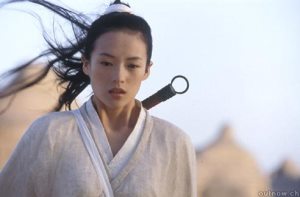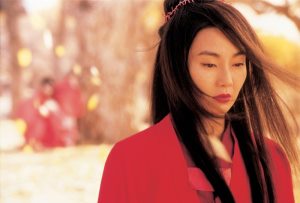
by Deborah Klens-Bigman, Ph.D.
Attractive and talented actors, high production values, and highly-choreographed martial arts scenes are just a few of the things Zhang Yimou's "Hero" (2002, but recently in general release here) has in common with Ang Lee's "Crouching Tiger, Hidden Dragon" (2000).
And they are basically the only things. Lee's "Crouching Tiger" tells a straightforward, romantic story. Zhang's "Hero" is a philosophical discourse on the nature of love, sacrifice and nationalism, set against stunning natural landscapes and fabulous courtyards and palaces.
"Hero" is unique among martial arts films (at least as we are used to seeing them here) and unique among most general-release films for that matter. (Audiences who were expecting Jet Li to star in a Chinese-style "Lethal Weapon"-type film must have gagged on their popcorn.) The story is fairly simple (and based on an ancient legend), but it is told no less than three different ways in the course of the film. The choreographed action is often encased in swirling fabric, falling leaves or hordes of computer-generated arrows. Strong colors dominate different scenes, which are almost like little films in themselves. The fight choreography is transformed into a highly-aestheticized dialogue between the fighters. As blows are given and taken, many of the points being made are philosophical, not merely physical. There is almost no blood to be seen, and no mayhem to speak of. Hundreds of extras (real and otherwise) swarm around the film, as soldiers and courtiers, giving the film an enormous, and surreal, sweep.
 Basically,
the film begins when a Hero, referred to as "Nameless" (Jet Li) is invited
and brought to the palace of the Emperor of Qin (Chen Daoming). The
larger-than-life palace setting is actually the Forbidden City, made available
courtesy of the government of China. Nameless is credited with having
vanquished three assassins, Sky (Donnie Yen), Broken Sword (Tony Leung
Chiu-Wai) and Flying Snow (Maggie Cheung). These three super-warriors
tried, time and again, to kill the Emperor, and thwart his plan to unite
the Six Kingdoms as one land. During the course of their meeting,
the story of how Nameless managed to defeat them all is told in several
different versions, with the last version being most truthful, if, in fact,
it can be called that.
Basically,
the film begins when a Hero, referred to as "Nameless" (Jet Li) is invited
and brought to the palace of the Emperor of Qin (Chen Daoming). The
larger-than-life palace setting is actually the Forbidden City, made available
courtesy of the government of China. Nameless is credited with having
vanquished three assassins, Sky (Donnie Yen), Broken Sword (Tony Leung
Chiu-Wai) and Flying Snow (Maggie Cheung). These three super-warriors
tried, time and again, to kill the Emperor, and thwart his plan to unite
the Six Kingdoms as one land. During the course of their meeting,
the story of how Nameless managed to defeat them all is told in several
different versions, with the last version being most truthful, if, in fact,
it can be called that.
Director Zhang has produced a very beautiful and highly formal film. Scenes are arranged and shot almost exclusively along a center and horizontal axis. Hordes of extras are often arranged around the edges of the frame, or in vertical lines, with the action taking place in the center. One recurring motif that works very well is that we see Nameless walking away at the end of nearly every scene, dead center in the frame, as the story moves from one version to the next. Somehow Li's retreating back takes on more poignancy each time, until the dramatic conclusion. (I won't give away the ending, but I have been told by several people that their dates cried at the end, even though I didn't.)
Two fight scenes stood out for me in particular. The first one
is at the beginning of the film, between Nameless and the first assassin,
Sky. Donny Yen is a superb stylist, and well matched with Li.
Their fight takes place at a chess hall open to the sky, that is being
soaked with intermittent rain. The scene is absolutely beautifully
choreographed and shot. The action and objectives of the fight choreography
and plot action are crystal clear. However, it is the only scene
like this in the entire film. From here, Zhang takes our conventional
expectations in hand and takes us in a totally different direction.

The other favorite scene is when Broken Sword, in one of the retellings,
manages to get into the audience hall of the Emperor's palace and confronts
the Emperor himself. They fight (of course), but the action takes
place amid swirls of green silk drapery. The antagonists alternately
stalk and feint at each other in what may as well be pitch darkness.
To martial arts fans, it is reminiscent of the Mirror Scene in "Enter the
Dragon," with a similar means of bringing the fight to an end (without,
however, the same denoument).
"Hero" demands a great deal of its actors, and they do not disappoint. Only Li's character remains more or less the same throughout the film while everyone else shifts personae, sometimes radically, to accommodate the shifting versions of the story. Of all of them, Maggie Cheung's Flying Snow has the most ground to cover, and she does it superbly, by turns hard and vicious, then meltingly, sadly beautiful. Throughout she battles Nameless time after time. Her performance alone makes the film worth seeing.
While the symmetrical staging of nearly every scene can wear down a Western audience, I realized right away what was guiding Zhang's hand - the story of "Hero" is being told through motifs from traditional Chinese opera. The formal staging, the swirling numbers of extras, the symbolic use of color (red for jealously, blue for heroism, you get the idea), different musical motifs for different types of scenes. Drums and real Chinese opera vocals underpin the fight scenes. Though the drumming does not punctuate the action the way it does in actual opera, the similarity is clear enough. The speeches are sometimes long, like recitative. You can almost hear the vocal line, especially when the Emperor of Qin declaims that he can see the principles of swordsmanship in a hanging piece of calligraphy. Chen Daoming has the handsome bearing and beautiful voice that is characteristic of the stock role of the emperor in traditional opera, an obvious casting choice that fits in with the classical interpretation.
As a scholar of Asian performance, I thoroughly enjoyed these theatrical aspects of the film. "Hero" looks like the logical extension of a classic form, expanded on the big screen, used to tell an epic tale, in typically non-linear fashion. My colleagues were, unfortunately, not as impressed, though they praised the beauty of the film, and its stylizations. Some people were bored, others bewildered.
The nationalist theme, especially present at the end of the film, could also be said to fit into a more modern form of Chinese opera, since discredited: Revolutionary Model Opera, popular during the abhorrent so-called Cultural Revolution. Apparently the nationalist theme was a factor in securing Chinese government support, which has led to charges that Zhang "sold out" in order to have his epic made to his satisfaction (previous Zhang films have not been viewed so favorably in official circles). Zhang's use of motifs from a classical performance genre which was banned for years in China suggests that question is complex and should be the subject for some other essay. Considering that the US has just gone through a period of flag-waving of its own, it may be better to let this issue alone for now.
